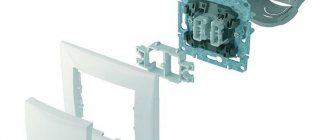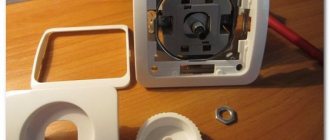Types of switches and operating principles
Based on the number of switched chains and the number of keys, all existing types of switches are divided into the following types:
- single-key models;
- two-key samples;
- three-key devices.
Another type of old device is still in use, in which the element that controls the switch mechanism is more like a button.
In addition, rare types of rotary-type switching products are presented on the domestic market. In terms of control method, they are a bit like a packet switch. There are also inexpensive Chinese devices related to touch sensitive devices. To control them, you don’t need much effort - just put your finger on the contact plate.
The operating principle of a conventional type switch is based on the closure of the moving and fixed contacts when the key is moved to the upper position and their opening when the reverse action occurs. The so-called “pass-through” switch works in the same way, differing from the usual one in the presence of additional groups of contacts, as well as in the method of inclusion in the lighting network.
Device
Before installing the switch, let's look at how this switching device works.
Let's do this using the example of the simplest single-key light switch. The most important part of this device is the operating mechanism. It is a metal frame on which a drive is attached, which directly turns the device on and off. Essentially, this drive is a moving contact that connects two fixed contacts of the switch. One fixed contact is incoming, a wire from the power supply is connected to it, the second is outgoing, and the wire is connected to the lamp. The correct position of these two fixed contacts is open, in which case the switch is considered to be off, the circuit between the power supply and the lamp is not closed, and the lamp does not light. As soon as the switch drive is affected, the movable contact takes a position in which it closes a circuit between two fixed contacts, voltage is supplied from the power source to the light bulb and it lights up.
Operating mechanism of the switch.
For safety reasons, the entire contact part is placed in some kind of dielectric (it can be plastic or porcelain). The switch is installed in wall holes, but before this, special socket boxes must be installed in the holes made in the wall. And the working mechanism of the switches is already fixed in them. Their reliable fixation is ensured by sliding legs located on the sides of the working part.
Another design component of switches is protective elements. As a rule, they are made of plastic. The first of these elements is a key; it is attached to the drive of the working part and directly controls the switching device. The second element is a protective frame; it covers the working part and prevents a person from touching the live contacts of the switch. The frame is secured with screws or plastic latches.
Causes of breakdowns
A faulty switch can be determined by the following signs:
- when you press a key or turn a toggle switch, knob, or other actions, the light does not turn on;
- turning on or off operations require multiple repetitions, keys or other elements work with jamming;
- an increase in the temperature of the light switching device housing is felt;
- after the circuit is closed, a crackling sound is heard or the lamp flickers;
- frequent burnout of light bulbs, regardless of their type (incandescent, LED, halogen, etc.);
- when the contacts in the switch close, a crackling sound is produced;
- The device does not connect to the network.
These problems may occur due to the following faults:
- Destruction of individual elements of the switch or melting of contacts.
- Violation of integrity and contact in the place of fixation of electrical wiring or terminals.
- The housing in the contact group is destroyed.
- The contact group is worn out.
The basic principle of operation of any type of switch is that it closes to turn on the light and opens the contacts to turn it off. However, often in more complex switch configurations, breakdowns can be even minor, which will prevent the luminaire circuit from closing.
Contactor selection
How to choose the right contactor or starter?
A modern modular contactor is no longer the bulky equipment it used to be.
It is compact (mounted on a DIN rail) and has no annoying noise during operation.
When choosing, first of all pay attention to the rated current. The most popular ones are 20A, 40A, 63A.
The contactor must calmly pass through itself not only the entire load connected through it, but also not melt if it is briefly exceeded. He doesn't have his own protection.
Mistake #2
Therefore, it is impossible for the rated current of the contactor to be less than the current of the input circuit breaker.
It is desirable that it exceed its value by one step. For example, a 25A or 32A machine – a 40A contactor; automatic 50A – contactor 63A, etc.
The current for which the contacts are designed can be found on the equipment body.
This inscription means that the device has two rows of contacts, designed for a maximum current of 20A on each pair.
That is, in total you can connect a load of 40A or ~ 8 kW to it.
Mistake #3
But this does not mean at all that it will be suitable for an input circuit breaker of 25A or 32A.
Also pay attention to other inscriptions and designations. For example, the letter “S” indicates that this is low-noise equipment.
Hager has such a series. For a house with a panel room indoors, it is advisable to buy silent models.
Disassembling the light switch
To repair a switch, you must first disassemble it. Let's get to work. Even though you have already turned off the power supply, check the voltage level using a multimeter. If you do not have such a device, use an indicator screwdriver, which you can purchase at your local hardware or electrical supply store.
Two-gang switch
- When starting to solve the problem of repairing a light switch, arm yourself with a thin screwdriver or knife in order to pry and remove the buttons, as well as the decorative cover of the switch from a special plastic box (socket box). New models usually have a recess to make it easier to lift the lid. Then you need to unscrew the screws located under the buttons. Don't forget to carefully place them in the prepared container.
- Remove the switch from the wall by unscrewing the fasteners, not forgetting to mark its position on the wall. Fastening elements may be different, depending on the material from which the wall is made.
- With a marker, mark the main wire attached to the main terminal, which is responsible for the voltage.
Safety precautions
You should always remember that before repairing a switch, socket or other equipment related to the operation of electric current, you should follow safety precautions. First, you need to turn off the power supply at the work site. This can be done using an electrical panel and the corresponding switches in it. Secondly, you should stock up on special tools. Required:
- Indicator screwdriver or multimeter.
- Marker.
- Small fine-grained skin.
- A regular Phillips screwdriver.
- Insulating tape.
Restoring rotary and touch models
Touch switches must be repaired in specialized workshops. In rotary-type devices, characteristic malfunctions have approximately the same causes and manifestations as in keyboard analogues. In their working mechanism, the closing and breaking contacts also burn out and completely wear out, which is explained by their intensive use. In addition, by analogy with the samples already considered, it is also possible for them to loosen the contacts at the points where the phase conductors are connected.
Restoring switches of this class is similar to the approach already discussed for key products. Difficulties arise when the cam mechanism breaks down, which is unlikely to be repaired manually. In this case, experts advise completely replacing the device with a new product.
Touch switches at home cannot be repaired. Due to the complexity of the design of the dimmer device, their restoration is possible only in specialized workshops.
Extension cord repair
Households often use extension cords to connect electrical appliances located at a great distance from outlets. They are produced in the form of surge protectors equipped with a switch for several outlets.
Dismantling
To find the breakdown, you will need to unplug the extension cord and disassemble it. Determine the location of the problem: block with socket, cable or plug. If it is impossible to determine the defect immediately upon inspection, the extension cord must be disassembled. All operations are performed according to the following algorithm:
- There are screws in several places that hold the top cover on a flat base with the wire and socket cores.
- It is necessary to unscrew all the bolts with a screwdriver.
- Place the screws in a separate container so as not to lose them during repairs.
- Unscrew the copper plates that come into contact with the wires.
Replacement and repair of parts
Depending on the problem, there may be several ways to repair the extension cord:
- If the wire is broken, look for the place of bad contact. To do this, connect an extension cord to the network, insert a table lamp or other device into it, which will signal the presence of current in the circuit with sound or light. The wire must be bent in different directions every 5 cm and see at what stage the connected device lights up or starts playing. This place must be carefully cut out, the wires exposed, soldered or twisted in pairs, and wrapped with electrical tape separately from each other.
- If the problem is in the plug, then most often a replacement with a new one is required, since cutting it and looking for the problem is a more expensive undertaking than replacing it.
- If the problem is inside the case with the extension cord sockets themselves, first check each of them for contact of the wires with the copper plate. If it is bad or missing, you need to wipe all contacts with a file. Most often, this operation corrects the problem. The plates must fit tightly to the fork, so you need to bend them in the right direction.
Repair procedure
So, your switch doesn’t work, you decided to repair it yourself and have already prepared the necessary tool. Now let’s move on directly to the repair, which will be easier for you to complete using these step-by-step instructions:
- To prevent electric shock during work, first of all, you need to de-energize the apartment by unscrewing the electrical plugs or turning off the switch.
- Make sure there is no voltage by checking any household outlet with an indicator screwdriver.
- Remove the light switch. To do this, you need to remove the decorative cover, additionally check with an indicator screwdriver that no current is supplied to the device, and then unscrew the side fastening screws. Now the body of the device can be pulled out of the socket box.
- Separate the electrical cables from the light switch. If the device has two keys, it is advisable to mark the input wire with a marker, otherwise they can be confused when connecting them back.
- Disassemble the body. This opens up access to the contacts, which are usually the cause of breaker failure. They are located under a plastic key fixed with screws.
- Perform a visual inspection of the contacts. If carbon deposits are found on them, remove it with sandpaper to restore the metallic shine.
Sometimes carbon deposits cannot be completely removed with sandpaper. In this case, the remnants of it must be removed with the tip of a slotted screwdriver.
The repair procedure is now complete. Now you should reassemble the switch in reverse order. To avoid confusion, you can use photographs that were taken during disassembly of the product.
How lighting works in bathrooms
This apartment has aluminum wiring, which is a big minus. When opening the bathroom switch, it turned out that it was working properly and that the apartment was one of those cases where it was not done entirely correctly - the switch opens zero, not phase.
Why is this done? I have asked myself this question more than once. In my apartment, the switch also opens zero.
For safety reasons, it has always been a rule that the light switch must open a phase. This is done so that when replacing a light bulb or wiping a chandelier, the likelihood of electric shock is minimal. It is enough to turn off the switch - and you can safely change the lamp with your bare hands or even dig into the socket. Naturally, first check the absence of a phase with an indicator screwdriver.
So why didn't electricians in older houses (more precisely, in houses where aluminum wiring is used) adhere to this important and simple rule? It turns out that the wire was simply with colorless (more precisely, white) insulation, and no one bothered to distinguish phase from zero. Are the sockets working? Are the lights on? What else does? The phase was observed only in the panel on the site, when connecting the meter and circuit breakers. And then, not always.
If done according to the rules, the lighting must go through a separate power line, through a separate circuit breaker with a current of no more than 10A, and all connections must be made in the distribution box above the switch. The phase opening has already been discussed above.
But these are the rules, but what really happens?
Switch installation
Having assembled the switch, we proceed to installing it in its original place. First of all, the input conductor marked with a marker must be connected to the common terminal, and then the remaining cables. After this, the device must be secured in the electrical outlet. Lastly, the housing frame and cover are installed.
Sometimes it is not possible to install the cover on the switch base. The reason, as a rule, is the incorrect position of the device body inside the socket box. It is necessary to loosen the fixing bolts with which the switch is held in the plastic box, and, having placed the device body in the desired position, tighten them again. If the product is in the correct position, the lid will easily fit into place.
Basic troubleshooting methods
Most often, when the device is turned on, the contacts burn out, and here it is recommended to simply clean the contact groups. It is better to do this with a small piece of sandpaper. Sometimes the switch does not work due to loose wire clamping, so it is necessary to check the functionality of the fixing screw.
The heavy operation of the switch, especially with the sliding type of contacts, is due to the fact that there is no lubrication, because of this the contact does not turn on the chain. The presence of melted plastic or crumbled ceramic housing means that the device is completely broken and must be permanently replaced.
Practical advice
- If an old-style switch breaks, you can of course fix it, but there is no point in doing so, because... Every part wears out over time, and in electrical work it is very dangerous to use old switches and sockets, especially if they often break down. Today, even such leading companies as Legrand have inexpensive but reliable products, even with lighting, a chain (cord) or a dimmer.
- The reason why the contacts on the key switch burn out quickly is because the light bulbs are too powerful. We recommend replacing incandescent lamps with more efficient and at the same time less powerful light sources - LED lamps. In this case, you can forget about repairing the switch for a long time.
- Before proceeding with complete disassembly of the case, check how well the wires are tightened with screws. You may be able to fix the switch simply by tightening the screws with a screwdriver.
- In order not to confuse the order of assembly of spare parts of a disassembled case, we recommend using a camera: take photographs of each of the disassembly stages one by one and, if necessary, assemble the structure from the photo.
That's all I wanted to tell you about how to fix a light switch with your own hands. We hope that the provided instructions and photo examples will help you repair a switch that does not turn off or turn on the lighting in the house!
Using the glow for good
Let me make a reservation right away: only “smoldering” lamps will do; it’s unlikely to work with blinking lamps. I personally witnessed the long operation of lamps in this mode, but I do not rule out that these experiments can significantly shorten the life of the lamps. There are too many different lamp designs and not enough data to make clear conclusions.
So, a weak glow can be used as a feature, an additional lighting option. A night light in the corridor, a romantic twilight in the room - “smoldering” can be used effectively. The main thing is to learn how to properly control this glow.
Good results will be achieved by proper “correct” wiring and switches without backlights. That is, when the lamp is turned off, it does not glow at all.
If the lamp glows initially, you can try connecting a capacitor in parallel with the lamp to eliminate it, and another capacitor, but of a larger capacity, to the second switch key. In general, you will have to experiment. But overall, I think this idea is quite interesting.
In all my experiments with the “night light” I used non-dimmable
lamps. The photo below shows two types of cheap lamps that “smolder”.
Reasons why the light bulb in the chandelier does not light
Prompt round-the-clock service by a professional electrician is what we do. Read and write reviews about our work
Expert opinion
Viktor Pavlovich Strebizh, lighting and electrical expert
Any questions ask me, I will help!
Quite rarely, but similar processes can occur without your intervention, then the insulation is broken and a fully functional switch does not affect the lighting at all. If there is something you don’t understand, write to me!











